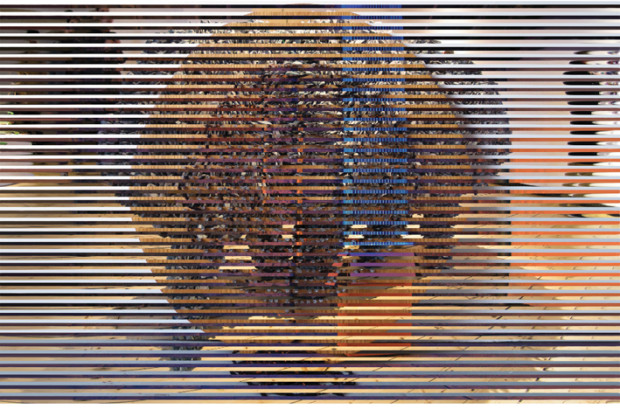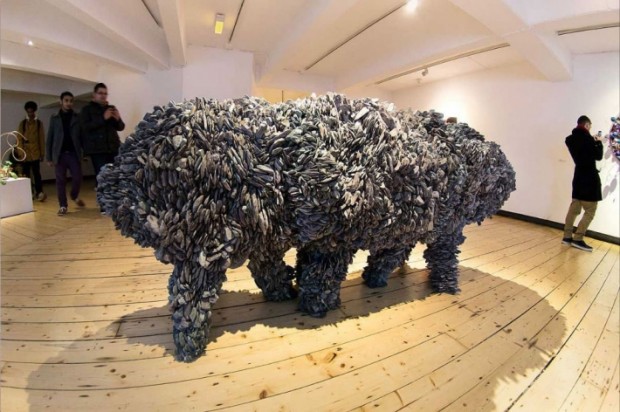I met up with Mark Devereux, curator and founder of Mark Devereux Projects, a new artist production-development organisation, to discuss his new venture:
JW: Why did you set up Mark Devereux Projects?
MD: The idea first came after I finished working with Blank Media Collective. I founded the organisation in 2006 and left my role as Director and Head of Exhibitions in July last year. After leaving, I took some time out to think about what I learned from that process. Speaking with hundreds of artists over this period, I found that a desire for more one-on-one guidance and support consistently arose. The whole exhibition process – from selecting proposals to conversations regarding the display and install – and the relationships that you build with an artist was something I enjoyed. At Blank Media, we covered lots of different art forms across many exhibitions. That’s similar to how a lot of galleries operate and while there’s no problem with that, when you build relationships with artists, you want that relationship to continue. I see the relationship between artists and myself as a collaboration as opposed to a one off curatorial project. I wanted to start with a concise focus on three artists to concentrate fully on their practice. It’s very much a listening process with each of the artists; what they want to achieve, what their ambitions are and how I can help support these goals. My role links in lots of different areas from mentoring to curation to representation.
JW: You currently support three artists: Nicola Dale, David Ogle and Nicola Ellis. How did you form these working relationships?
MD: I held initial meetings with the artists to find out about their current practice. These meetings were key to finding how committed they are to developing their practice and if that they’re in it for the long term. I have known all three for a while now: I worked with David a few times with Blank Media, I have had many conversations and studio visits with Nicola Dale and I have known about Nicola Ellis’s work through various Blank Media projects. So I have been able to see that progression already and how they’ve developed over this period. It is very important how I can help aid that progression.
David Ogle, 08005, 2011
dimensions variable, fluorescent fishing line, ultraviolet light, cardboard box
JW: Would you consider supporting more artists in the future?
MD: It has the potential for sure. However as I’m on my own, I don’t want to overdo it – I don’t want to take on too many artists and lose that focus. It’s more about slowly building relationships. While there’s potential to get more artists on board in the future, I’d also be happy to work with the three artists.
JW: When you consider working with an artist, what do you look for in their work?
MD: First and foremost, the work has got to excite me in some way. It has to create a response and generate intrigue towards their practice.
JW: Why did you decide to work with early-career artists?
MD: It is the journey, such as frequently exhibiting and working with other curators, towards that next stage in their career that interests me. There is terminology such as emerging, mid-career artists; but how do you bracket people? It is very difficult. One artist might define success differently to another.
JW: How do you define success?
MD: For me, success is ticking the boxes of what artists want to achieve. An example being if an artist wanted to get represented by a gallery and I took them to that stage, then I have helped them to reach their goal. Obviously, I want to be successful in what I’m doing but I want these artists to succeed, not just promoting what I’m doing.
JW: I think a lot of people can fail to recognise that.
MD: There are some curators and directors in the field who are out there purely to further their own reputation. For me, that role should be about the artist, supporting them and putting their work out there.
JW: As a practicing artist, do you ever feel conflicted working with artists as opposed to concentrating on your own work?
MD: Not anymore. I took timeout after Blank Media to consider that. I was very careful to make sure that everything I am doing now is everything I am passionate about. There are lots of different elements to what I’m doing but at the same time, there is a clear structure and reason and output. There aren’t any conflicts anymore.
JW: A key theme of your first MDP exhibition ‘Means of Feedback’ is the recognition in the shift of artists towards a DIY approach outside of a formal educational context. With new modes of peer engagement being explored, perhaps out of necessity, how can organisations support artists?
MD: There’s a growing recognition that things need to change, starting with that educational aspect. More and more people will find it difficult to go through higher and further education. In the music industry, for example, new academies have sprung up to support talent. The visual arts sector needs to respond to these changes in some way. More and more you start to notice artist led systems that are being brought into space. Galleries are being pushed to think about artists in their region. Castlefield Gallery have also started up their CG Associates programme that operates in a similar style to MDP Associate Membership.
Means of Feedback: Nicola Dale, 8866 Full Stops for Spinoza (2012) | David Ogle, 08005 (2011) | Nicola Ellis, Peregro (2013)
JW: What impact do you feel schemes like MDP Associate Membership and GG Associates can have on artists in the region?
MD: The key thing is focus. There are a lot of services out there such as workshops, talks and portfolio reviews. They all provide different sources of information, which is great. However as an artist myself, I found that there is sometimes only a few things that you can draw from each of those sessions. I wanted to narrow it and find out about the needs of each individual artist, and in a one-to-one situation, answer specific worries and questions that they need help with. Artists don’t need to worry about standing up in public and asking questions if they don’t wish to. I want to get across that I could help them solve that query and perhaps help their work progress.
JW: Can these initiatives also help to retain talent in the region?
MD: The retention of creative people in the north is vital. Kerry Harker from PSL in Leeds has written an essay for the new Mark Devereux Projects publication about the retention of creative people in the North. Every organisation and gallery in the region has a responsibility to do its upmost to keep these creative people here. There are a lot of draws to London or abroad and, yes: I think we, cultural organisations and institutions, need to address that. MDP is responding to that in a very small way at the moment. I am based in Manchester and that is where I concentrate my work and support for artists. However it is very important not to be completely fixed to that area.
JW: So this flexibility would, in theory, allow you temporarily set up in London if a project required it?
MD: Yes, there is that potential. Possibilities such as this informed my decision not to open a gallery and be tethered to a space. You don’t want to be showing the same artists and the same work to the same people; that doesn’t provide near enough development. Being flexible in this manner enables new exhibition opportunities and allows visits to new countries/places that could potentially inspire new work.
JW: In this aspect, MDP operates on a similar level to a gallerist. Where you differ, aside from declining to set up a physical gallery space, is that you also appear to have little interest in collecting.
MD: The development of the artists is key. If collecting is something that the artist is interested in, then that is considered. It always comes back to the artists’ goals. There is no need to force that, as there are so many avenues to go down: it has got to be right. There are so many reasons why you should probably have a gallery and potentially in the future that might happen. As there is more of a reason of what I wanted to achieve with the artists, there’s more of a reason why a gallery isn’t necessary. Galleries, from my experience, bring up a lot more work, a lot more pressure and that potentially dilutes the focus. It starts become about the building as opposed to the artists.
JW: Your first exhibition – Means of Feedback – opens at CUBE in Manchester in July. Is the exhibition a prologue to MDP and it’s objectives?
MD: Very much so. While MDP has been launched online, the exhibition will provide that first initial insight. It will provide a context to the organisation while showcasing new work by each of the three artists. Additionally there is going to be commissioned videos giving insight into the working processes of the three artists. The exhibition is very much an opportunity to showcase their ideas and make a physical introduction to MDP. In the future, there will be dedicated solo exhibitions and more curated and produced elements. I think that will keep developing.
Nicola Ellis, Peregro, 2013 Polyurethane, wrought iron, silicone and paddlestone. Commissioned by Cornerhouse for FOUR exhibition. Photography by six eight three.
JW: Who is your target audience for this exhibition?
MD: For this show, it is a mix, but there is a key focus on inviting curators, directors, producers; people that we want to work with in the future but make that introduction. However I want different communities to engage with the work – I don’t want it to become exclusive to certain arts audience and not the general public. It’s creating that balance: we all have an obligation to making art accessible and exciting.
JW: As a potentially high-risk solo venture, do you worry about failure?
MD: Everyone worries about failure! We all want to be successful but from my experiences: if you believe in it, you can make it happen. That goes for anyone and everything. I did that with Blank Media taking it from nothing to leaving it with a strong reputation. You’ve got to trust in your passion and dedication. Things are bound to be difficult at some point down the line but I know what can be achieved. Failure can drive your development; if things are too easy, you can start to drift.
JW: Did you find that happened to you at Blank Media?
MD: I think I got it to a point where I couldn’t develop the organisation any further; I couldn’t add anything new to it. It felt the right time to move on. Since leaving, I haven’t regretted it. In one aspect, it was letting go of the biggest thing I’ve ever done, but making those decisions helped to form something new and exciting.
JW: What excites you about art at the moment?
MD: It excites me that as money isn’t as readily available as it is not as easy. I think that this climate spurs more focus, more dedication and results in more challenging work that pushes boundaries. The climate is difficult but being ambitious enough to think outside the box can be rewarded.
Means of Feedback: Nicola Dale | David Ogle | Nicola Ellis CUBE, Manchester, 12 – 17 July 2013
Preview and launch of Mark Devereux Projects: 11 July, 6-9pm
MDP After Hours at Whitworth Art Gallery: 13 July 7:30-10:30pm


